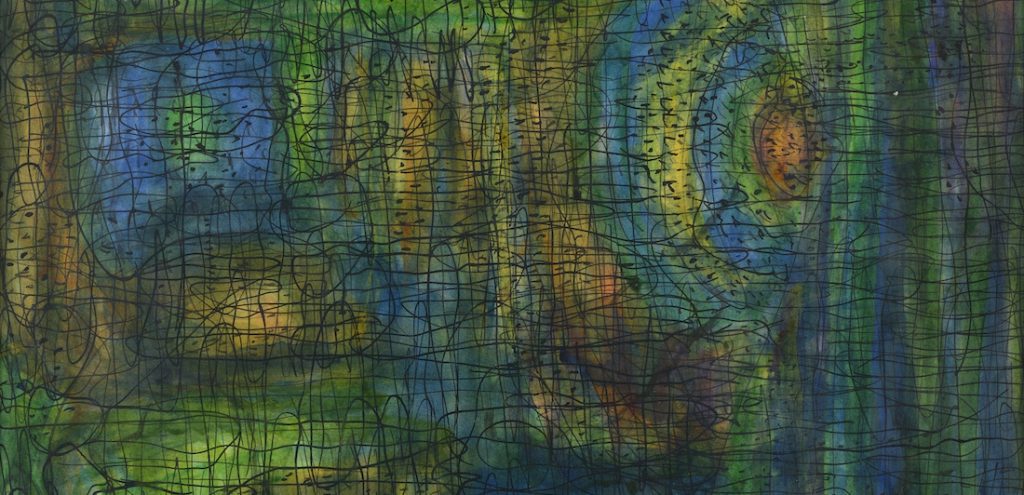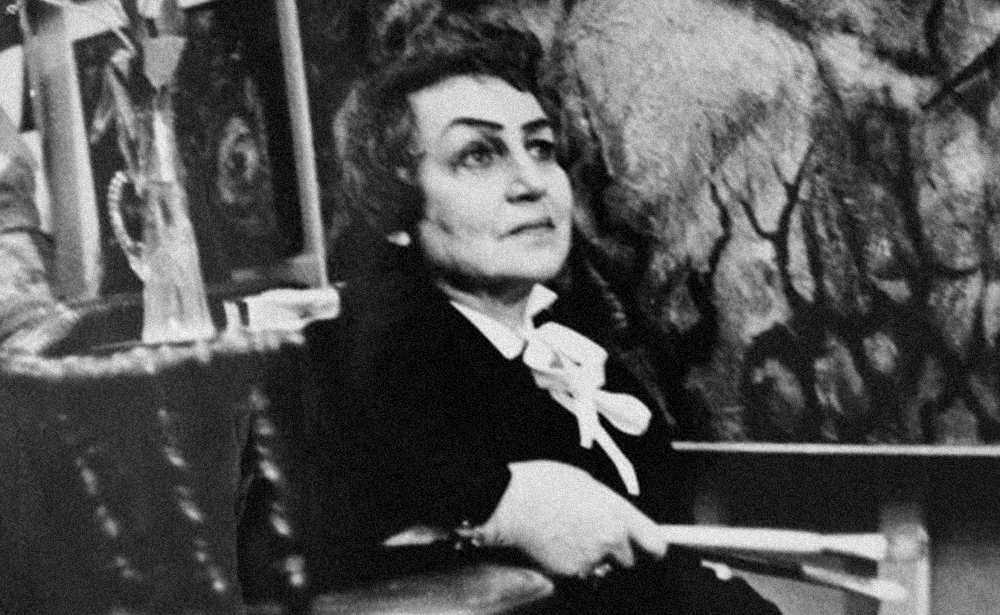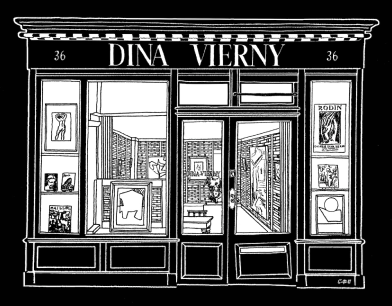

Fahr-el-Nissa Zeid was born in 1901 in Istanbul. Her father, Shakir Pasha, the brother of the grand Vizier, Cevat Pasha, was an historian, teacher and diplomat. Shakir and Cevat Pasha played a major role in the historical culture of their country. At the age of 19, Fahr-el-Nissa-Zeid was among the first women to attend the Academy of Fine Art in Istanbul and, in 1920, she married the writer and president of the emperor’s Ottoman company of tobacco, Izzet Melieh Devrin. In 1928, she moved to Paris to pursue her studies…
Fahr-el-Nissa Zeid was born in 1901 in Istanbul. Her father, Shakir Pasha, the brother of the grand Vizier, Cevat Pasha, was an historian, teacher and diplomat. Shakir and Cevat Pasha played a major role in the historical culture of their country.
At the age of 19, Fahr-el-Nissa-Zeid was among the first women to attend the Academy of Fine Art in Istanbul and, in 1920, she married the writer and president of the emperor’s Ottoman company of tobacco, Izzet Melieh Devrin. In 1928, she moved to Paris to pursue her studies at the Académie Ranson – Ranson Academy – with Bissière as a teacher. She moved back to Istanbul in 1930, where she worked as an independent artist.
Like many Turkish intellectuals of that time, Fahr el Nissa Zeid and her husband joined the Mustafa Kemal movement that later led to the development of the Republic.
Following the dissolution of her first marriage, Fahr el Nissa Zeid married the prince of the House of Hashim, Prince Zeid, in Bagdad. One of his brothers was the Transjordan Emir Abdulla, grandfather of the present king of Jordan, another brother, Faisal, later became King of Irak.
The Zeid couple lived successively in Ankara, where Prince Zeid was an ambassador, in Berlin between 1934 and 1938, in Budapest between 1939 and 1940, before finally coming back to Istanbul where the Princess decided to fully commit to her painting career in 1941.
Her first exhibition took place in 1944 in her own apartment. In 1947, she moved to London where she had several exhibitions, one of which was attended by Queen Elisabeth.
Around the same time, she bought a studio in rue de Grenelle, in Paris, and actively participated in discussions regarding the abstract movement of the Second School of Paris. She exhibited at Colette Alendy and Dina Vierny and was strongly supported by the critic Charles Estienne. Fahr-el-Nissa Zeid led a double life between Paris and Badgad until the Hashemite royal house was overthrown and her husband, the only survivor, joined her in Paris.
Following the death of the Prince in 1970, Princess Zeid joined her family in Amman where she created the Fahr-el-Nissa Zeid Institute of Fine Art. Fahr-el-Nissa Zeid died in 1991 in Amman.
By combining, in an exuberant abstract style, her oriental influences – such as Islamic and Byzantine art – with her discoveries and studies of abstract art, conducted in the Western World, Fahr-el-Nissa Zeid’s work reflects the exuberance of the story of her art and her life.
Fahrelnissa Zeid, Tate Modern, London (June 13 – October 17); Deutsche Bank KunstHalle, Berlin; Sursock Museum, Beirut
Fahrelnissa Zeid, Istanbul Modern, Istanbul
Fahr El Nissa Zeid: Entre l’Orient et l’Occident, Peintures et Dessins, Un Rétrospectif, Institut du Monde Arabe, Paris ; Neue Gallerie Sammlung Ludwig, Aachen
Fahr-El-Nissa Zeid, Galerie Katia Granoff, Paris (May 30 – June 24)
Fahrelnissa Zeid, peintures et paléokrystalos, Galerie Katia Granoff, Paris
Fine Arts Academy, Istanbul (May)
Hittite Museum, Ankara (June)
Fahr-El-Nissa Zeid, Peintures 1954-1961, Galerie Dina Vierny, Paris (May 19 – June 17)
Fahrelnissa Zeid, Lord’s Gallery, London
Palais des Beaux-Arts, Galerie Aujourd’hui, Brussels
Fakhr-El-Nissa Zeid, Gouaches et lithographies d’ailleurs, À la Hune, Paris (November)
Recent Paintings by Fahr-El-Nissa Zeid, Institute of Contemporary Arts, London (July 8 – 31)
Far-El-Nissa Zeid, Galerie Dina Vierny, Paris (December 4 – January 7, 1954)
Galerie Seize, Zurich
Peintures, gouaches, lithos, Galerie de Beaune, Paris
Hugo Gallery, New York
Portraits, Galerie Colette Allendy, Paris
Gimpel Fils, London
Saint-George Gallery, London
Maison du peuple, Smyrne
Elles font l’abstraction, Musée d’art moderne – Centre Georges Pompidou, Paris (May 19 – August 23)
Fahrelnissa and Nejad: Two Generations of the Rainbow, Istanbul Modern, Istanbul
L’ile de l’Homme errant, Galerie Kleber, Paris
Alice au pays des merveilles, Galerie Kléber, Paris
Serge Poliakoff – Fahr-El-Nissa Zeid, Galerie Dina Vierny, Paris
Lord’s Gallery, London
8ème salon des réalités nouvelles, Musée d’art moderne de la Ville de Paris, Paris (July 10 – August 9)
L’École de Paris, Galerie Babylone, Paris
Exposition internationale de l’Unesco, Musée Cernuschi, Paris
Fahr-el-Nissa Zeid was born in 1901 in Istanbul. Her father, Shakir Pasha, the brother of the grand Vizier, Cevat Pasha, was an historian, teacher and diplomat. Shakir and Cevat Pasha played a major role in the historical culture of their country.
At the age of 19, Fahr-el-Nissa-Zeid was among the first women to attend the Academy of Fine Art in Istanbul and, in 1920, she married the writer and president of the emperor’s Ottoman company of tobacco, Izzet Melieh Devrin. In 1928, she moved to Paris to pursue her studies at the Académie Ranson – Ranson Academy – with Bissière as a teacher. She moved back to Istanbul in 1930, where she worked as an independent artist.
Like many Turkish intellectuals of that time, Fahr el Nissa Zeid and her husband joined the Mustafa Kemal movement that later led to the development of the Republic.
Following the dissolution of her first marriage, Fahr el Nissa Zeid married the prince of the House of Hashim, Prince Zeid, in Bagdad. One of his brothers was the Transjordan Emir Abdulla, grandfather of the present king of Jordan, another brother, Faisal, later became King of Irak.
The Zeid couple lived successively in Ankara, where Prince Zeid was an ambassador, in Berlin between 1934 and 1938, in Budapest between 1939 and 1940, before finally coming back to Istanbul where the Princess decided to fully commit to her painting career in 1941.
Her first exhibition took place in 1944 in her own apartment. In 1947, she moved to London where she had several exhibitions, one of which was attended by Queen Elisabeth.
Around the same time, she bought a studio in rue de Grenelle, in Paris, and actively participated in discussions regarding the abstract movement of the Second School of Paris. She exhibited at Colette Alendy and Dina Vierny and was strongly supported by the critic Charles Estienne. Fahr-el-Nissa Zeid led a double life between Paris and Badgad until the Hashemite royal house was overthrown and her husband, the only survivor, joined her in Paris.
Following the death of the Prince in 1970, Princess Zeid joined her family in Amman where she created the Fahr-el-Nissa Zeid Institute of Fine Art. Fahr-el-Nissa Zeid died in 1991 in Amman.
By combining, in an exuberant abstract style, her oriental influences – such as Islamic and Byzantine art – with her discoveries and studies of abstract art, conducted in the Western World, Fahr-el-Nissa Zeid’s work reflects the exuberance of the story of her art and her life.
Fahrelnissa Zeid, Tate Modern, London (June 13 – October 17); Deutsche Bank KunstHalle, Berlin; Sursock Museum, Beirut
Fahrelnissa Zeid, Istanbul Modern, Istanbul
Fahr El Nissa Zeid: Entre l’Orient et l’Occident, Peintures et Dessins, Un Rétrospectif, Institut du Monde Arabe, Paris ; Neue Gallerie Sammlung Ludwig, Aachen
Fahr-El-Nissa Zeid, Galerie Katia Granoff, Paris (May 30 – June 24)
Fahrelnissa Zeid, peintures et paléokrystalos, Galerie Katia Granoff, Paris
Fine Arts Academy, Istanbul (May)
Hittite Museum, Ankara (June)
Fahr-El-Nissa Zeid, Peintures 1954-1961, Galerie Dina Vierny, Paris (May 19 – June 17)
Fahrelnissa Zeid, Lord’s Gallery, London
Palais des Beaux-Arts, Galerie Aujourd’hui, Brussels
Fakhr-El-Nissa Zeid, Gouaches et lithographies d’ailleurs, À la Hune, Paris (November)
Recent Paintings by Fahr-El-Nissa Zeid, Institute of Contemporary Arts, London (July 8 – 31)
Far-El-Nissa Zeid, Galerie Dina Vierny, Paris (December 4 – January 7, 1954)
Galerie Seize, Zurich
Peintures, gouaches, lithos, Galerie de Beaune, Paris
Hugo Gallery, New York
Portraits, Galerie Colette Allendy, Paris
Gimpel Fils, London
Saint-George Gallery, London
Maison du peuple, Smyrne
Elles font l’abstraction, Musée d’art moderne – Centre Georges Pompidou, Paris (May 19 – August 23)
Fahrelnissa and Nejad: Two Generations of the Rainbow, Istanbul Modern, Istanbul
L’ile de l’Homme errant, Galerie Kleber, Paris
Alice au pays des merveilles, Galerie Kléber, Paris
Serge Poliakoff – Fahr-El-Nissa Zeid, Galerie Dina Vierny, Paris
Lord’s Gallery, London
8ème salon des réalités nouvelles, Musée d’art moderne de la Ville de Paris, Paris (July 10 – August 9)
L’École de Paris, Galerie Babylone, Paris
Exposition internationale de l’Unesco, Musée Cernuschi, Paris

Fahr-el-Nissa Zeid was born in 1901 in Istanbul. Her father, Shakir Pasha, the brother of the grand Vizier, Cevat Pasha, was an historian, teacher and diplomat. Shakir and Cevat Pasha played a major role in the historical culture of their country. At the age of 19, Fahr-el-Nissa-Zeid was among the first women to attend the Academy of Fine Art in Istanbul and, in 1920, she married the writer and president of the emperor’s Ottoman company of tobacco, Izzet Melieh Devrin. In 1928, she moved to Paris to pursue her studies…
Fahr-el-Nissa Zeid was born in 1901 in Istanbul. Her father, Shakir Pasha, the brother of the grand Vizier, Cevat Pasha, was an historian, teacher and diplomat. Shakir and Cevat Pasha played a major role in the historical culture of their country.
At the age of 19, Fahr-el-Nissa-Zeid was among the first women to attend the Academy of Fine Art in Istanbul and, in 1920, she married the writer and president of the emperor’s Ottoman company of tobacco, Izzet Melieh Devrin. In 1928, she moved to Paris to pursue her studies at the Académie Ranson – Ranson Academy – with Bissière as a teacher. She moved back to Istanbul in 1930, where she worked as an independent artist.
Like many Turkish intellectuals of that time, Fahr el Nissa Zeid and her husband joined the Mustafa Kemal movement that later led to the development of the Republic.
Following the dissolution of her first marriage, Fahr el Nissa Zeid married the prince of the House of Hashim, Prince Zeid, in Bagdad. One of his brothers was the Transjordan Emir Abdulla, grandfather of the present king of Jordan, another brother, Faisal, later became King of Irak.
The Zeid couple lived successively in Ankara, where Prince Zeid was an ambassador, in Berlin between 1934 and 1938, in Budapest between 1939 and 1940, before finally coming back to Istanbul where the Princess decided to fully commit to her painting career in 1941.
Her first exhibition took place in 1944 in her own apartment. In 1947, she moved to London where she had several exhibitions, one of which was attended by Queen Elisabeth.
Around the same time, she bought a studio in rue de Grenelle, in Paris, and actively participated in discussions regarding the abstract movement of the Second School of Paris. She exhibited at Colette Alendy and Dina Vierny and was strongly supported by the critic Charles Estienne. Fahr-el-Nissa Zeid led a double life between Paris and Badgad until the Hashemite royal house was overthrown and her husband, the only survivor, joined her in Paris.
Following the death of the Prince in 1970, Princess Zeid joined her family in Amman where she created the Fahr-el-Nissa Zeid Institute of Fine Art. Fahr-el-Nissa Zeid died in 1991 in Amman.
By combining, in an exuberant abstract style, her oriental influences – such as Islamic and Byzantine art – with her discoveries and studies of abstract art, conducted in the Western World, Fahr-el-Nissa Zeid’s work reflects the exuberance of the story of her art and her life.
Fahrelnissa Zeid, Tate Modern, London (June 13 – October 17); Deutsche Bank KunstHalle, Berlin; Sursock Museum, Beirut
Fahrelnissa Zeid, Istanbul Modern, Istanbul
Fahr El Nissa Zeid: Entre l’Orient et l’Occident, Peintures et Dessins, Un Rétrospectif, Institut du Monde Arabe, Paris ; Neue Gallerie Sammlung Ludwig, Aachen
Fahr-El-Nissa Zeid, Galerie Katia Granoff, Paris (May 30 – June 24)
Fahrelnissa Zeid, peintures et paléokrystalos, Galerie Katia Granoff, Paris
Fine Arts Academy, Istanbul (May)
Hittite Museum, Ankara (June)
Fahr-El-Nissa Zeid, Peintures 1954-1961, Galerie Dina Vierny, Paris (May 19 – June 17)
Fahrelnissa Zeid, Lord’s Gallery, London
Palais des Beaux-Arts, Galerie Aujourd’hui, Brussels
Fakhr-El-Nissa Zeid, Gouaches et lithographies d’ailleurs, À la Hune, Paris (November)
Recent Paintings by Fahr-El-Nissa Zeid, Institute of Contemporary Arts, London (July 8 – 31)
Far-El-Nissa Zeid, Galerie Dina Vierny, Paris (December 4 – January 7, 1954)
Galerie Seize, Zurich
Peintures, gouaches, lithos, Galerie de Beaune, Paris
Hugo Gallery, New York
Portraits, Galerie Colette Allendy, Paris
Gimpel Fils, London
Saint-George Gallery, London
Maison du peuple, Smyrne
Elles font l’abstraction, Musée d’art moderne – Centre Georges Pompidou, Paris (May 19 – August 23)
Fahrelnissa and Nejad: Two Generations of the Rainbow, Istanbul Modern, Istanbul
L’ile de l’Homme errant, Galerie Kleber, Paris
Alice au pays des merveilles, Galerie Kléber, Paris
Serge Poliakoff – Fahr-El-Nissa Zeid, Galerie Dina Vierny, Paris
Lord’s Gallery, London
8ème salon des réalités nouvelles, Musée d’art moderne de la Ville de Paris, Paris (July 10 – August 9)
L’École de Paris, Galerie Babylone, Paris
Exposition internationale de l’Unesco, Musée Cernuschi, Paris
Galerie Dina Vierny
36 rue Jacob 75006 Paris
Open from Tuesday to Saturday from 10 a.m. to 7 p.m.
Galerie Dina Vierny
36 rue Jacob 75006 Paris
Open from Tuesday to Saturday from 10 a.m. to 7 p.m.
